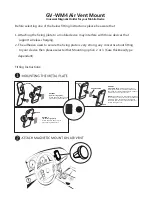
Copyright Velocomp LLP 2005-2015
44
APPENDIX 2: “FTP”, “NP”, “TSS”, AND “IF”: WHAT
ARE THEY, AND HOW DO I BENEFIT FROM THEM?
Your Newton includes Normalized Power
TM
(NP), Training Stress Score
TM
(TSS), and
Intensity Factor
TM
(IF) measurements. If you are a seasoned veteran of power training,
you realize how important this information can be, and how great it is that the Newton can
display this information on the road.
TSS, IF, and NP were developed by well-known exercise physiologist Dr. Andrew R.
Coggan. These three measurements use the “raw” power data from your Newton,
along with sophisticated mathematical formulas, to provide more detailed
information about the intensity and quality of your workouts. If you have never
heard of these three useful factors, then keep reading to find out what they are and how
they can help you get the most out of your workouts and your fitness
improvement goals.
GETTING STARTED: DETERMINING YOUR FUNCTIONAL THRESHOLD POWER (FTP)
Before you can obtain TSS, IF and NP measurements you need to have a “baseline”
that characterizes your current level of fitness. This reference point is called your
“Functional Threshold Power”, or FTP.
One way to determine your FTP is to do a one hour Time Trial; your average watts
for that one hour period is your FTP. Another way to estimate your FTP is by using
the Newton’s 20 minute fitness test. The Newton 20 minute fitness test is similar to a
time trial, just shorter in time. To estimate your FTP from the Newton fitness test,
take the watts per kilogram number shown in your “FIT TEST” screen, multiply that
number by your weight (in kilograms), then multiply that number by 0.95. For
example, if your W/KG measurement is 3.02 and your weight is 81KG, then your
estimated FTP is 3.02 *81 *.95 = 233W.
Once you have determined your FTP number from either method, you must enter
that value into the Newton. Go to Setup/FTP CFG (FTP Configuration). Click the
center button, then use the arrows to enter your FTP in watts. Click the center
button to Accept.
If you’re training regularly you’ll want to check your FTP about once a month.
NORMALIZED POWER (NP)
Have you ever participated in a group ride where your watts are never steady?
Group rides can be very difficult, but afterwards you might suspect that your average watts
don’t accurately reflect how difficult the ride was. The disparity between measured and
perceived effort is due to coasting, surging, using brakes, and soft pedaling. In fact,
your average watts will be lower than your perceived effort suggests. This is where
Normalized Power (NP) comes in.
NP takes your “raw” power data and gives you a related power measurement number
(reported in watts) that better represents the “tax” on your body for the ride, especially
when you’re varying your power output considerably from moment to moment. For
example, in a criterium, the NP number will be much higher than the average power
because the NP measurement does a better job of accounting for the effects of coasting
and large power surges. The NP number will be more representative your effort for the
ride.













































